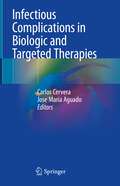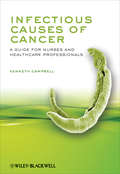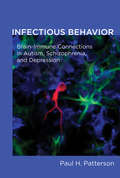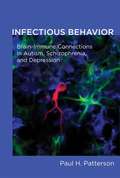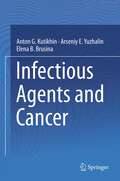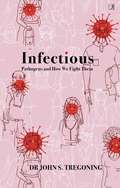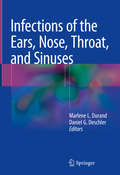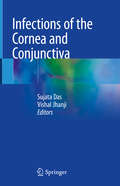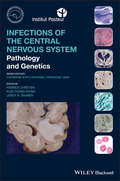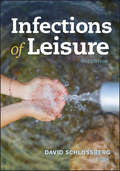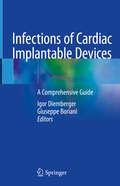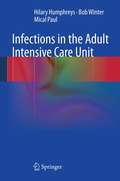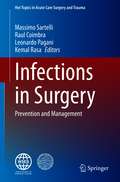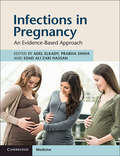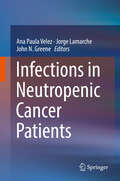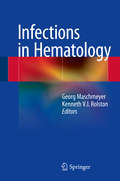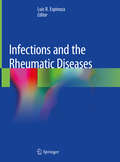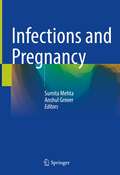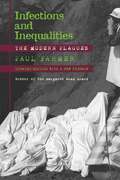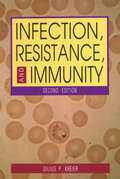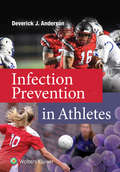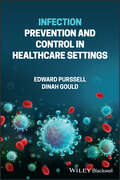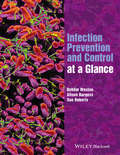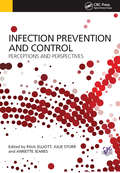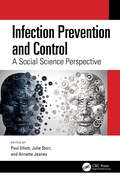- Table View
- List View
Infectious Complications in Biologic and Targeted Therapies
by Carlos Cervera Jose Maria AguadoThis book aims to approach the epidemiology, diagnosis and management of infectious complications related to the use of biologic and targeted therapies. The first part is a general overview on the epidemiology and prevention of infections with the use of these agents. Timelines, pre-treatment evaluation, use of vaccines and travel counseling. In the second part, we will analyze the specific risk of infections associated with the use of the most important agents. The third part approach the problem on a syndromic point of view. For example, how to evaluate pulmonary infiltrates in a patient receiving biologic agents. This part III includes the most difficult and conflicting syndromes that clinicians may face when evaluating these patients.This book is intended not only for infectious diseases specialists, but also for different medical specialties prescribing biologic and targeted therapies.
Infectious Causes of Cancer
by Kenneth CampbellOver 99% of the world's population is infected with at least one potentially cancer-causing organism. It is vital for nurses and other healthcare professionals to be aware of the extent of infection-associated cancer and of how they can contribute to prevention of such cancers.Infectious Causes of Cancer, aimed principally at nurses and other healthcare professionals, considers the epidemiology and biology of infectious causes of cancer. It examines each of the infectious agents associated with an increased risk of cancer, discussing epidemiology of the infection and cancer, pathophysiology of the cancer, mechanisms, associated risk factors, and prevention of the infection and cancer.Key Features:A comprehensive and accessible guide to infection associated cancer and how to contribute to preventionA must-have for students or healthcare professionals working in oncology, primary care or health promotionBrings together all the up-to-date science, evidence and research related to infections and cancer in one publication
Infectious Behavior: Brain-Immune Connections in Autism, Schizophrenia, and Depression
by Paul H. PattersonAn examination of brain-immune system communication in autism, schizophrenia, and depression.In Infectious Behavior, neurobiologist Paul Patterson examines the involvement of the immune system in autism, schizophrenia, and major depressive disorder. Although genetic approaches to these diseases have garnered the lion's share of publicity and funding, scientists are uncovering evidence of the important avenues of communication between the brain and the immune system and their involvement in mental illness. Patterson focuses on this brain-immune crosstalk, exploring the possibility that it may help us understand the causes of these common, but still mysterious, diseases. The heart of this engaging book, accessible to nonscientists, concerns the involvement of the immune systems of the pregnant woman and her fetus, and a consideration of maternal infection as a risk factor for schizophrenia and autism. Patterson reports on research that may shed light on today's autism epidemic. He also outlines the risks and benefits of both maternal and postnatal vaccinations.In the course of his discussion, Patterson offers a short history of immune manipulation in treating mental illness (recounting some frightening but fascinating early experiments) and explains how the immune system influences behavior and how the brain regulates the immune system, looking in particular at stress and depression. He examines the prenatal origins of adult disease and evidence for immune involvement in autism, schizophrenia, and depression. Finally, he describes the promise shown by recent animal experiments that have led to early clinical trials of postnatal and adult treatments for patients with autism and related disorders.
Infectious Behavior
by Paul H. PattersonIn Infectious Behavior, neurobiologist Paul Patterson examines the involvement of the immune system in autism, schizophrenia, and major depressive disorder. Although genetic approaches to these diseases have garnered the lion's share of publicity and funding, scientists are uncovering evidence of the important avenues of communication between the brain and the immune system and their involvement in mental illness. Patterson focuses on this brain-immune crosstalk, exploring the possibility that it may help us understand the causes of these common but still mysterious diseases. The heart of this engaging book, accessible to nonscientists, concerns the involvement of the immune systems of the pregnant woman and her fetus, and a consideration of maternal infection as a risk factor for schizophrenia and autism. Patterson reports on research that may shed light on today's autism epidemic. He also outlines the risks and benefits of both maternal and postnatal vaccinations. In the course of his discussion, Patterson offers a short history of immune manipulation in treating mental illness (recounting some frightening but fascinating early experiments) and explains how the immune system influences behavior and how the brain regulates the immune system, looking in particular at stress and depression. He examines the prenatal origins of adult disease and evidence for immune involvement in autism, schizophrenia, and depression. Finally, he describes the promise shown by recent animal experiments that have led to early clinical trials of postnatal and adult treatments for patients with autism and related disorders. For questions for the author, and updates on the various topics covered in the book since its publication, please check the book's website: http://mitpress. mit. edu/infectiousbehavior
Infectious Agents and Cancer
by Anton G. Kutikhin Elena B. Brusina Arseniy E. YuzhalinOver the years of cancer investigation a lot of discoveries in this field were made, and many associations between various biological carcinogens and cancer were revealed. Some of them are credibly determined, thus these infectious agents (human papilloma virus, hepatitis B virus, hepatitis C virus, Epstein-Barr virus, human herpes virus 8, human T-cell lymphotropic virus 1, human immunodeficiency virus, Merkel cell polyomavirus, Helicobacter pylori, Opisthorchis viverrini, Clonorchis sinensis, Schistosoma haematobium) are recognized as carcinogens and probable carcinogens by International Agency for Research on Cancer (IARC). The problem is of large importance, since share of infectious agents-related cancer cases is steadily increasing, reaching 25% according to certain estimates. It is worth noting that many of cancer cases are caused by infectious agents other than «conventional ones» like HPV, EBV, HBV, HCV, H.pylori etc. In recent years, a number of significant breakthroughs in the field were performed, such as the discovery of the microbiota role in cancer causation.
Infectious: Pathogens and How We Fight Them
by Dr John S. Tregoning&‘This book catapults us to the frontier of the vital science of infections and immune responses. Tregoning is a perfect guide, writing with wit and intelligence about a subject which surely everyone feels the importance of now. Brilliant and right on the zeitgeist.&’Daniel M. Davis, author of The Beautiful Cure and The Secret Body &‘Packed with fascinating facts, intriguing anecdotes and more than a few Dad jokes, Infectious is an expertly guided, pacey tour through the world of all the stuff that&’s trying to kill us and how our immune systems and human ingenuity are fighting back.&’Dr Kat Arney, science communicator and author of Rebel Cell: Cancer, Evolution and the Science of Life Nature wants you dead. Not just you, but your children and everyone you have ever met and everyone they have ever met; in fact, everyone. It wants you to cough and sneeze and poop yourself into an early grave. It wants your blood vessels to burst and pustules to explode all over your body. And – until recently – it was really good at doing this… COVID-19 may be only the first of many modern pandemics. The subject of infection and how to fight it grows more urgent every day. How do pathogens cause disease? And what tools can we give our bodies to do battle? Dr John S. Tregoning has dedicated his career to answering these questions. Infectious uncovers fascinating success stories in immunology and virology, making this book not only a vital overview of infection, but also a hopeful story of ongoing human ingenuity.
Infections of the Ears, Nose, Throat, and Sinuses
by Marlene L. Durand Daniel G. DeschlerThis text serves as a practical but comprehensive guide to diagnosing and treating ear, nose, throat, and sinus infections. The 30 chapters have been contributed by otolaryngologists and infectious disease specialists who are experts in the field. Topics include common infections such as otitis media, otitis externa, pharyngitis, laryngitis, and acute bacterial sinusitis, as well as less common infections such as mumps, scrofula, malignant otitis externa, Lemierre’s syndrome, invasive fungal sinusitis, and deep neck infections. Human papillomavirus-related neoplasms, biofilms, chronic sinusitis, antibiotic-resistant infections, and measures to prevent surgical site infections are also discussed. Written with the practicing clinician in mind, Infections of the Ears, Nose, Throat, and Sinuses will be an invaluable aid to otolaryngologists, infectious disease specialists, internists, pediatricians, and primary care providers.
Infections of the Cornea and Conjunctiva
by Sujata Das Vishal JhanjiThis book presents the clinical features, invasive and non-invasive modalities of diagnosis of conjunctival and corneal infections, especially atypical clinical situations in unusual cases of keratitis, and manage the disease entity. Infections of cornea continues to be the leading cause of ocular morbidity and blindness worldwide. Early diagnosis helps in better outcome. Proper understanding of the microbiological and clinical characteristics of this disease entity enables ophthalmologists to initiate appropriate therapy. Corneal infections, especially due to uncommon organisms, are difficult to diagnose and treat. With 17 chapters, this volume covers the entire spectrum of corneal and conjunctival infections. This is a quick go-to book for general as well as specialist ophthalmologists.
Infections of the Central Nervous System: Pathology and Genetics (International Society of Neuropathology Series)
by Francoise Gray Katy KeohaneHighly commended at the British Medical Association (BMA) Awards 2019, this new volume from the International Society of Neuropathology series addresses infections of the nervous system, written by expert editors. An expansive and inclusive contents list including rare disorders presented in easily referable chapters, containing; definitions, microbiological characteristics, epidemiology, clinical features, lab tests, pathology, genetics and treatment.
Infections of Leisure (ASM Books #50)
by David SchlossbergA day at the beach: delightful, restorative – and potentially dangerous. Leisure activities, from the mundane to the exotic, expose us to a growing list of pathogenic microbes, some new and many increasingly resistant to current therapies. Common pets, livestock, traveling, and cuisine all have the potential to cause illnesses that may be difficult to diagnose and treat. Engagingly written by a team of infectious disease specialists and edited by David Schlossberg, Infections of Leisure features 19 chapters focused on the infection risks associated with particular types of activities, including camping, playing sports, interacting with animals, receiving body modifications, and mountain climbing. This new edition includes vibrant, full-color images, recommended readings chosen by expert authors, and practical tips in each chapter. Useful for health care professionals, microbiologists, and infectious diseases specialists, the information in Infections of Leisure will support confident identification of leisure-associated infections and enable informed choices, as well as provide an understanding of the risks posed to human health by hobbies, exotic foods and travel.
Infections of Cardiac Implantable Devices: A Comprehensive Guide
by Igor Diemberger Giuseppe BorianiCardiac implantable device (CIED) infections are a key issue since they have serious consequences in terms of morbidity, mortality and associated costs for healthcare systems. Such infections are highly complex, which has implications for prevention (several factors underlie its development), diagnosis (requiring patient specific integration of several elements), acute treatment (choice of the antibiotic, lead extraction procedure), as well as long-term management (CIED re-implantation strategy and follow-up). Dealing with CIED infections requires appropriate organization of healthcare provision, with the creation of integrated hub-spoke referrals, and it has prompted many of the recent developments in CIED technologies: leadless pacemakers, subcutaneous defibrillators, antibacterial envelops and lead extraction devices. This book systematically examines all aspects of this multifaceted condition, discussing each clinical and organizational issue in a separate self-contained chapter. It starts by reviewing the epidemiology/pathophysiology of CIED infections, and then addresses acute and long-term management. Offering a comprehensive overview of the prevention of infections, considering both current and future perspectives, the book also provides practical suggestions along with recommendations from the literature in the field. This is the first book entirely focused on CIED infections. Written by an international team of leading experts it will appeal to broad audience, including cardiologists, electrophysiologists, infectious disease specialists, internists, healthcare professionals, health service managers and providers, researchers and those working in industries involved in the field.
Infections in the Adult Intensive Care Unit
by Bob Winter Mical Paul Hilary HumphreysThe book will provide some basic aspects of the pathophysiology of infection, but essentially the book will be practical-based and use case-illustrations to highlight key aspects of diagnosis, management and prevention. Through a combination of text, tables, figures/line drawings, clinical illustrations and other illustrations, it is hoped to provide a comprehensive, interesting and stimulating approach to this important subject. Guidance on the appropriate use of laboratory investigations, as well as radiology, together with templates to use for deciding on the optimal choice of anti-infective agents will be amongst the strengths of this book.
Infections in Surgery: Prevention and Management (Hot Topics in Acute Care Surgery and Trauma)
by Massimo Sartelli Raul Coimbra Leonardo Pagani Kemal RasaAlthough most clinicians are aware of the problem of antimicrobial resistance, most also underestimate its significance in their own hospital. The incorrect and inappropriate use of antibiotics and other antimicrobials, as well as poor prevention and poor control of infections, are contributing to the development of such resistance. Appropriate use of antibiotics and compliance with infection prevention and control measures should be integral aspects of good clinical practice and standards of care. However, these activities are often inadequate among clinicians, and there is a considerable gap between the best evidence and actual clinical practice. In hospitals, cultural determinants influence clinical practice, and improving behaviour in terms of infection prevention and antibiotics-prescribing practice remains a challenge. Despite evidence supporting the effectiveness of best practices, many clinicians fail to implement them, and evidence-based processes and practices that are known to optimize both the prevention and the treatment of infections tend to be underused. Addressing precisely this problem, this volume offers an essential toolkit for all surgeons and intensivists interested in improving their clinical practices.
Infections in Pregnancy: An Evidence-Based Approach
by Adel Elkady Prabha Sinha Hassan Soad Ali ZakiVerified by current World Health Organization and country-specific classifications, this comprehensive single volume effectively engages with the diagnosis and management of viral, bacterial, fungal and parasitic diseases that affect women in pregnancy. This comprehensive book provides focused, relevant information, on newer viruses causing epidemics, including Dengue, Chikungunya and the Zika virus. With today's ease of world migration, this text covers infections found in both tropical and temperate climates, highlighting newer and rapid diagnostic methods, particularly for resource-poor settings, and clinicians working in remote and diverse locations. Designed for professionals with busy schedules, this guide provides efficient solutions and relevant information regarding investigation, diagnosis and treatment of common maternal infections, worldwide.
Infections in Neutropenic Cancer Patients
by Ana Paula Velez Jorge Lamarche John N. GreeneAs bone marrow transplant treatments and chemotherapy develop, the population of neutropenic cancer patients is on the rise. These developments are allowing patients to live longer, but in recent years, they have also led to an increase in previously rare infections and syndromes, whose management is unfamiliar to the average healthcare professional. Infections in Neutropenic Cancer Patients is a crucial resource for medical students, residents, practitioners, health professionals, and researchers. It details the clinical presentation, diagnoses, and management of an array of common infections and syndromes specific to neutropenic cancer patients, including real scenarios accompanied by color photos and radiographic results. Chapters include step-by-step tutorials, access to clinical answers on diagnosis and treatment, and a tabulated summary of the key points.
Infections in Hematology
by Georg Maschmeyer Kenneth V.I. RolstonInfections are among the most frequent complications in patients with hematological malignancies and in those undergoing high-dose chemotherapy and autologous hematopoietic stem cell transplantation. A profound knowledge on the epidemiology, diagnostic approaches, treatment modalities and prophylactic strategies is essential for the clinical management of these complications in patients who are often severely immunocompromised owing to their underlying diseases and in particular, the intensive myelosuppressive chemo and immunotherapy. This textbook provides a clinically oriented, compact and up-to-date overview on infections in hematology patients and their management. The typical pathogens to be considered in different subgroups of patients are identified and further aspects of the microbiological background are explored. Clinical, imaging, and laboratory-based diagnostic techniques are discussed and therapeutic strategies appropriate to different situations are then presented, with due attention to the pitfalls, toxicities and interactions that can arise during antimicrobial treatment. Strategies to prevent infection are also outlined, encompassing antimicrobial prophylaxis, isolation procedures, hospital hygiene, protective immunization and the use of hematopoietic growth factors.
Infections and the Rheumatic Diseases (The\clinics)
by Luis R. EspinozaThis book provides a comprehensive and up-to-date review of the basic and clinical aspects of infections and infectious processes that trigger or aggravate a variety of autoimmune and inflammatory musculoskeletal disorders. It delivers a timely update on the interactions between infection and rheumatic diseases in order to provide clinicians with the tools they need for proper diagnosis and treatment.The book is divided into five main sections. The first examines the basic aspects of bacterial infections with a discussion of molecular biology, the microbiome, various types of bacteria that cause infection, and recent advances in biologic therapy. The next section focuses on different forms of viral arthritis including hepatitis arthritis, arthritis associated with alpha viruses, and parvovirus-related arthritis. Subsequent chapters then discuss arthritis caused by mycobacteria, fungi, spirochete, and other miscellaneous arthritides. Following this are various analyzations on reactive arthritis and infection-related rheumatic diseases such as Whipple’s Disease, SAPHO Syndrome, rheumatic fever, and HIV-associated rheumatic manifestations. Finally, the book closes with three chapters on external impacts on infectious diseases such as climate change, vaccinations and systemic lupus erythematosus.Infections and the Rheumatic Diseases is an essential resource for physicians and related professionals, residents, fellows, graduate students, and nurses in rheumatology, clinical immunology, and internal medicine.
Infections and Pregnancy
by Sumita Mehta Anshul GroverThis book is a complete guide to the diagnosis and management of any infectious disease which may affect the mother or the fetus during pregnancy. Pregnancy is a unique condition in which the interplay of endocrine and immune influences leads to altered severity and susceptibility to infectious diseases. These infections, in turn, are a substantial cause of maternal and perinatal morbidity.The book discusses the immunologic, clinical and epidemiologic evidence for altered responses during pregnancy. Several infections have unique consequences in pregnancy. Some infections have vertical transmission, and their management focuses on decreasing perinatal transmission. Others can be transmitted transplacentally and cause congenital infection. While still, other common infections like gastroenteritis, UTI, tuberculosis, leprosy or certain dermatological and oral conditions can cause pregnancy complications. This book discusses all such diseases in detail as well as suggests means for early identification and appropriate treatment for them. A separate chapter adequately covers the novel coronavirus infection associated with management challenges in pregnant women. The book includes dedicated sections on postpartum infections and fetal outcomes associated with maternal infections. It reviews strategies to prevent infection in obstetrics that plays a key role in decreasing the global burden of maternal morbidity and mortality. The book is relevant for practicing obstetricians and gynecologists, post-graduate students of obstetrics and gynecology as well as general practitioners, family medicine specialists, primary health care workers and undergraduate medical students.
Infections and Inequalities
by Paul FarmerPaul Farmer has battled AIDS in rural Haiti and deadly strains of drug-resistant tuberculosis in the slums of Peru. A physician-anthropologist with more than fifteen years in the field, Farmer writes from the front lines of the war against these modern plagues and shows why, even more than those of history, they target the poor. This "peculiarly modern inequality" that permeates AIDS, TB, malaria, and typhoid in the modern world, and that feeds emerging (or re-emerging) infectious diseases such as Ebola and cholera, is laid bare in Farmer's harrowing stories of sickness and suffering. Challenging the accepted methodologies of epidemiology and international health, he points out that most current explanatory strategies, from "cost-effectiveness" to patient "noncompliance," inevitably lead to blaming the victims. In reality, larger forces, global as well as local, determine why some people are sick and others are shielded from risk. Yet this moving account is far from a hopeless inventory of insoluble problems. Farmer writes of what can be done in the face of seemingly overwhelming odds, by physicians determined to treat those in need. Infections and Inequalities weds meticulous scholarship with a passion for solutions--remedies for the plagues of the poor and the social maladies that have sustained them.
Infection, Resistance, and Immunity, Second Edition
by Julius KreierDesigned as an introductory textbook, Infection, Resistance and Immunity provides basic information on the workings of the immunological system and on infectious processes and their control. With sections on immunological disorders, immunization, immunodiagnosis, and epidemiology, it relates immunology to practical problems in medicine. The book includes a section on comparative immunology, introducing students to differences among immunological systems among common species of nonhuman animals. Written for the advanced undergraduate, the focus is on host-parasite interactions—distinguishing this text from other standard texts, which focus on the cellular mechanisms of the immune response.
Infection Prevention in Athletes
by Deverick AndersonDerived from protocols developed for the National Football League, Infection Prevention in Athletes outlines best practices and recommendations that are designed to minimize the risk of infections among athletes. This unique resource provides concise, authoritative guidance for athletic training facilities on applying infection prevention practices typically provided in hospitals and outpatient clinics. You’ll find practical tips and real world advice on preventing transmission of bacterial and viral infections in an environment of frequent skin injuries, close proximity of players, and frequent administration of routine medical care.
Infection Prevention and Control in Healthcare Settings
by Edward Purssell Dinah GouldINFECTION PREVENTION AND CONTROL IN HEALTHCARE SETTINGS In Infection Prevention and Control in Healthcare Settings, a team of distinguished researchers deliver an accessible and authoritative introduction to infection control and prevention in hospital and community settings. This is a key resource as professionals deal with the ongoing impact of the COVID-19 pandemic, and require the latest and most up-to-date information. Central topics are discussed at the individual and population levels, with direct links to lessons learned throughout the COVID-19 pandemic. The book is written from an evidence-based perspective that utilises modern approaches, reflecting current decision-making methods like GRADE and WHO Evidence to Decision Frameworks. Readers will also find: A thorough introduction to the chain of infection and the main groups of micro-organisms causing infection Comprehensive explorations of the application of evidence-based practice principles to infection prevention and control Practical discussions of immunity, microbiology laboratories, antimicrobial drugs, and policies and protocols for infection prevention and control The role of epidemiology and public health in the prevention and control of infectious disease Perfect for student nurses and students of allied health professions, Infection Prevention and Control in Healthcare Settings will also benefit practitioners and managers in the health services seeking to update their knowledge of infection control and prevention in healthcare settings.
Infection Prevention and Control at a Glance
by Debbie Weston Sue Roberts Alison BurgessInfection Prevention and Control at a Glance isthe perfect companion for study and revision for pre-registration nursing and healthcare students, as well as qualified nurses and medical students. Infection prevention and control is one of the key five 'essential skills clusters' that is incorporated into all pre-registration nursing programmes. This highly visual and dynamic book is a thorough resource for nurses wanting to consolidate and expand their knowledge of this important part of nursing. Written by experienced infection prevention and control specialist nurses, it provides a concise and simple approach to a vast and complex subject, and equips the reader with key information in relation to various aspects of infection prevention and control practice. Provides a snap-shot of the application of infection prevention and control in practice and the key infections affecting patients in both acute and primary care A uniquely visual and accessible overview of a topic of relevance to all nursing staff Includes key points for clinical practice, patient management, and signposting of key national guidance documents and websites Available in a wide-range of digital formats - perfect for 'on the go' study and revision
Infection Prevention and Control: Perceptions and Perspectives
by Paul Elliott Julie Storr Annette JeanesThis book presents a variety of perceptions of and perspectives on infection prevention and control. In doing this, the chapters will reflect upon challenging and controversial new ways of looking at infection prevention and control aimed at generating both discussion and debate as well as practical solutions. With this in mind, the book will aim not only to challenge the existing status quo but also push the frontiers of knowledge, thinking and practice where infection prevention and control is concerned. This is vital when considered in the light of cross infection rates, the number of healthcare providers who are being identified by the Care Quality Commission as falling below acceptable standards of infection prevention and control and the almost compulsive persistent non-adherent behaviours of those involved in the provision of medicine, health, social care and other disciplines related to caring with regards to the undertaking of safe and appropriate standards of infection prevention and control. There is no doubt that this book will be challenging with regards to the readers' perceptions and perspectives of infection prevention and control. Where this topic is concerned however, such a challenging approach is vital if the health, safety and well being of individuals is to be positively promoted among all those involved in the health and wellbeing of others.
Infection Prevention and Control: A Social Science Perspective
by Paul Elliott Julie Storr Annette JeanesAn understanding of the social sciences within infection prevention and control (IPC) is important for those working in health and social care. This new book, Infection Prevention and Control: A Social Science Perspective positions the specialty of IPC as more than a technical discipline concerned with microbes. It is about people and their behaviour in context and the book therefore explores a number of relevant social sciences and their relationship to IPC across different contexts and cultures. IPC is relevant to every person who works in, and accesses health care and it remains a global challenge. Exploring novel approaches and perspectives that expand our collective horizons in an ever changing and evolving IPC landscape therefore makes sense. Key Features: Offers new perspectives beyond the topic area of infection prevention and control, to push the frontiers of knowledge and to challenge the status quo. Interprofessional in nature and relevant to all those involved in the provision of medicine, health, and social care irrespective of their roles. Truly international in nature in that the chapters have been developed by a range of individuals from across the globe.
